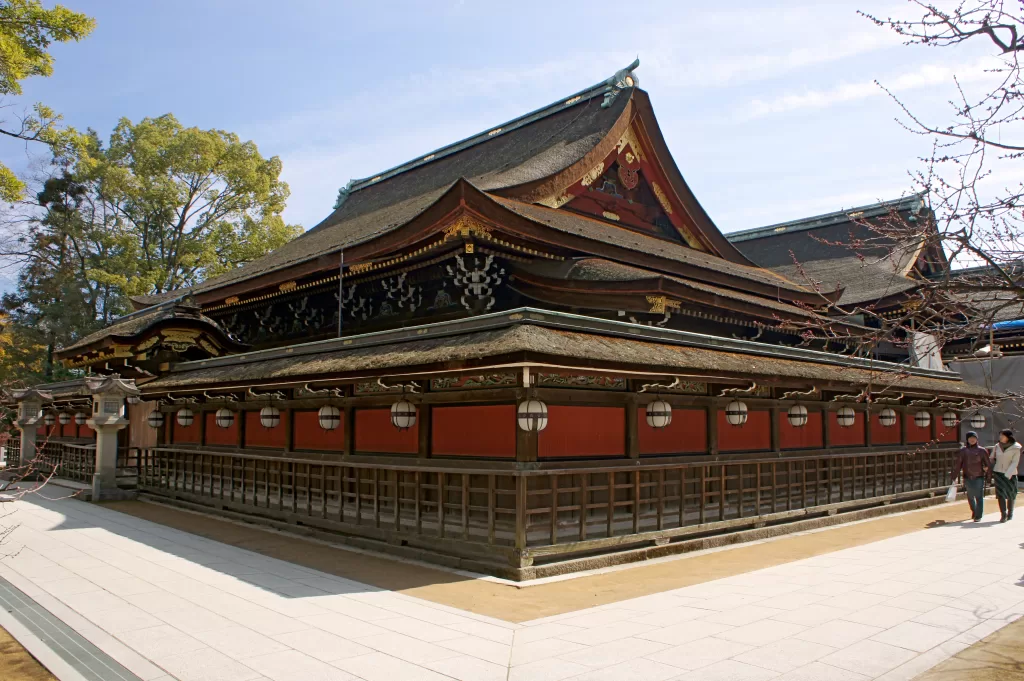Zuiki Matsuri: A Thousand-Year-Old Celebration of Gratitude for a Bountiful Harvest

A Historical Background: The Kitano Tenmangu Shrine
Established in 947, the Kitano Tenmangu Shrine has a significant place in Japanese history. Enshrining Sugawara Michizane, a renowned scholar, litterateur, and politician from the Heian Era (living from 845 to 903), this shrine is the headquarters of over 12,000 Tenmangu shrines that exist all over Japan. Fondly referred to as “Tenjin san” by local people and devotees, the Kitano Tenmangu Shrine plays host to countless seasonal events throughout the year.
These events range from Ume tree blossoms in spring to vibrant autumn festivals like the Zuiki Matsuri Festival. The latter gives thanks for bumper crop harvests and has become an iconic event in Kyoto’s calendar. Zuiki Matsuri is one of the most awaited Kyoto events in October.
The Unique Mikoshi and Taro Stem Connection
At the heart of the Zuiki Matsuri Festival lies the Mikoshi, a portable shrine intricately decorated with vegetables and other dried products. These portable shrines are used for various rituals during the five-day celebration.
The term “Zuiki” refers to the stem of taro plants. This festival originated as a ritual offering of new crops, fruits, and vegetables before the altar. As such, the Mikoshi design uniquely incorporates these natural elements: taro stems are used for constructing the roof of the shrine, while dried greens, marigolds, tofu skin, and wheat provide additional aesthetic details.
On each side of these portable shrines are art panels depicting legendary scenes and creatures created using vegetables. Strings of vibrant scarlet eggplants, citrus fruits, and peppers hang as decorations off each corner.
The Festivities and Ceremonies
Throughout its five-day duration, participants engage in various ceremonial activities at the Zuiki Matsuri Festival. One notable occasion is the ritual of transferring the spirit to the portable shrine from the main shrine. Following this, three Horen (imperial carriages) and Matsu-hoko (long-handled spears) leave the shrine, accompanied by around 350 priests and shrine parishioners parading around its vicinity.
A special attraction of this festival is the Yaotome Dance, performed by primary school girls chosen from within the shrine area at the beginning and end of the celebration. Their costumes are a sight to behold, coupled with refined and elegant dance moves that pay homage to an ancient tradition.

The Processions: A Journey Through Neighborhoods
The Zuiki Matsuri Festival begins with a procession leaving Kitano Tenmangū Shrine on the first day. Several ornately decorated omikoshi take center stage as it makes its way through neighborhoods before reaching a temporary shrine where various rituals are conducted.
The festival culminates in one final procession as devotees carry portable shrines back to Kitano Tenmangū. This parade features ox-drawn carts and concludes the following day with a final Yaotome Dance offering.
Geiko and maiko from Kamishichiken district witness these processions donned in their traditional full splendor as they move through streets resonating with gratitude for plentiful harvests.
A Celebration Connecting People with Nature
Having evolved from a historical custom linked to Kitano Matsuri Festival (Reisai Festival), where people adorned Mikoshi with vegetables that had been offered before the altar, Zuiki Matsuri’s unique Mikoshi decorations display an intertwining relationship between humans and nature.
As we trace its roots back more than 1,000 years ago, this five-day long festival remains an important celebration of cultural heritage in Kyoto.
As visitors flock to partake in this jubilant event every October, locals find joy in not only the festivities but also the simple, yet powerful connection to nature, through a celebration that appreciates an abundant harvest.
If you want to experience a mesmerizing journey through the rich history of Kyoto, experience the fiery spectacle of the Kurama Fire Festival. This ancient celebration ignites the town of Kurama in Kyoto every October 22nd.